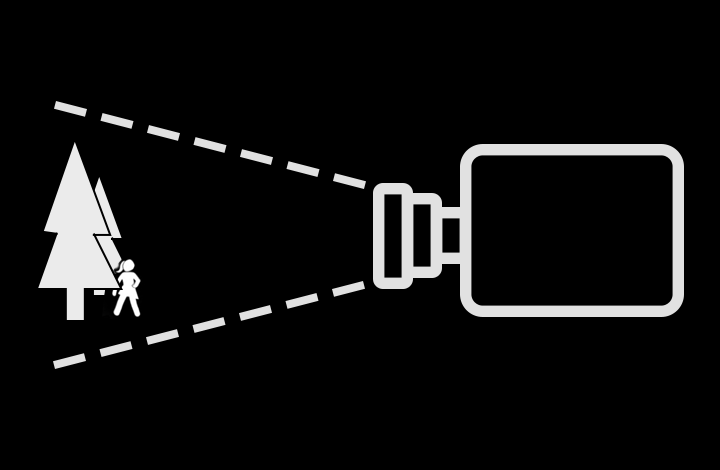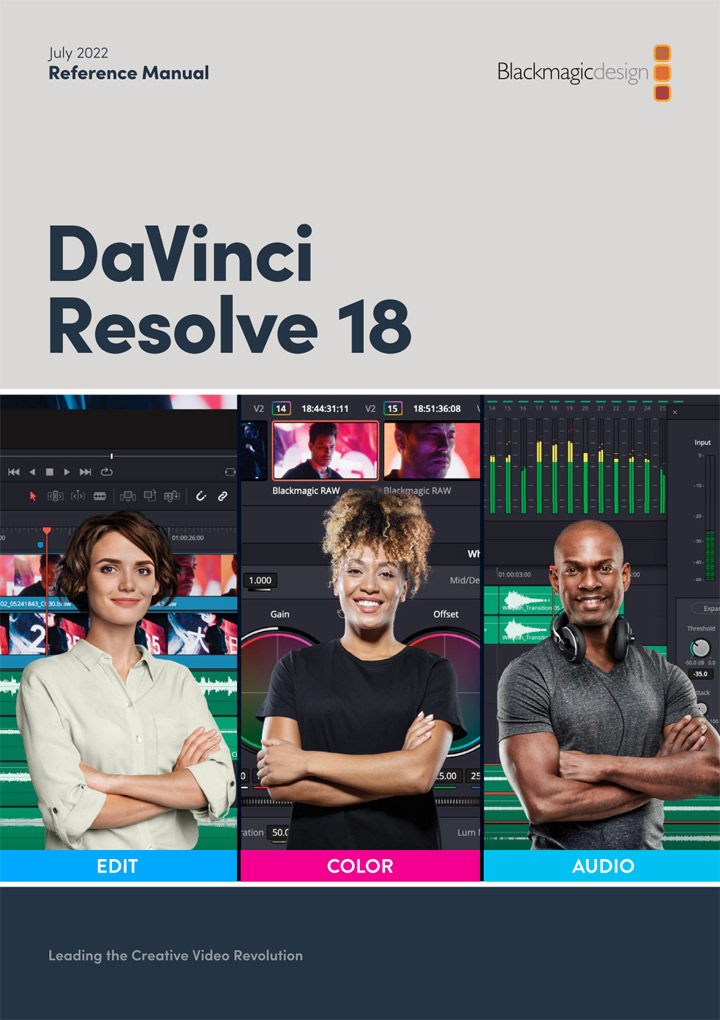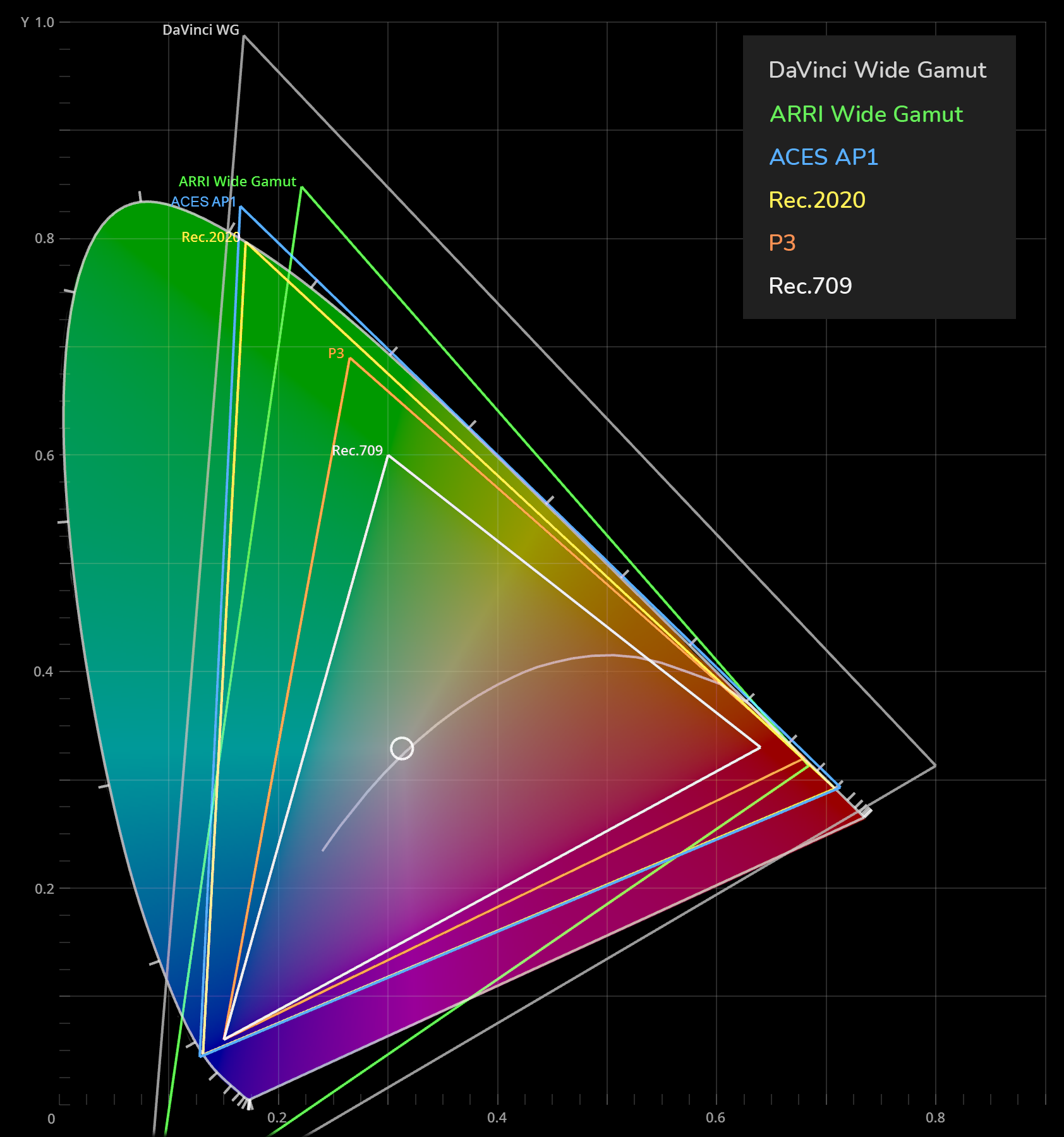COLOR MANAGEMENT
IN DAVINCI RESOLVE
INTRODUCTION
UNDERSTANDING
COLOR MANAGEMENT
Color management in film and video ensures consistent color reproduction throughout the entire production pipeline—from capture (camera) to final display (cinema screen, TV, or monitor). In this article, I will break down the fundamentals of color management, focusing on the key differences between “scene-referred” and “display-referred” workflows. Additionally, I will explore the scene-referred workflow in depth, supported by a CIE diagram and instructive videos.

SCENE
REFERRED
Digital cameras are designed to capture a vast dynamic range, accurately mirroring the original scene. By employing a scene-referred workflow, I can work within this extensive color range, preserving the full dynamic range and color information captured by the camera.
This often involves staying in the camera’s log format, though other expansive color spaces—such as ACES (Academy Color Encoding System) or DaVinci Wide Gamut (DWG)—can also be utilized. These methods maximize the potential of captured data, allowing for greater flexibility in post-production.

DISPLAY
REFERRED
Historically, during the analog film era, workflows were predominantly display-referred. Rather than capturing and working within a broad dynamic range, content was immediately transformed into a display-specific color space, primarily Rec. 709.
Because grading was done within this restricted color space, it adhered to the technical limitations of the display. While practical for its time, this method sacrificed detail, particularly in highlights and shadows, and often resulted in color inconsistencies when viewed across different screens.
Advantages of Scene-Referred
Over Display-Referred Workflows
In the past, display-referred workflows were standard but had notable limitations. Since they were confined to a specific display’s capabilities, they often resulted in:
- Color inconsistencies across different display types
- Loss of detail, particularly in highlights and shadows
On the other hand, scene-referred workflows are far more versatile, as they:
- Preserve the original details and colors captured by the camera
- Offer greater flexibility in post-production
- Ensure consistency across multiple viewing platforms, from HDR and Rec. 709 to cinema projection
By working in a scene-referred space, I can maintain creative intent while ensuring a true-to-life representation across all display formats.
SCENE REFERRED
WORKFLOW
EXAMPLE
In a node-based workflow, I begin by grading in the camera’s Log space. Only at the end of my node tree (e.g., at the Timeline level) do I apply a Color Space Transform (CST) to convert the image from Log to Rec. 709. This ensures that all grading adjustments are applied before the transformation occurs, retaining the full dynamic range.
SCENE REFERRED
WORKFLOW
ANOTHER EXAMPLE
Building upon the scene-referred approach:
- I start with the camera’s Log space
- I apply a CST to convert the footage to DaVinci Wide Gamut Intermediate (DWG)
- After performing all grading adjustments in DWG, the final node converts the image to a chosen display format, such as Rec. 709
This method allows me to retain as much color information as possible before the final conversion.
ACES WORKFLOW
ANOTHER SCENE REFERRED WORKFLOW
Consider another scene-referred workflow utilizing the ACES (Academy Color Encoding System) model:
- The IDT (Input Device Transform) translates the image data from its initial format into the ACES color space.
- The RRT (Reference Rendering Transform) introduces an ACES-defined look, crafted to emulate the characteristics of traditional film.
- Finally, the ODT (Output Device Transform) transforms the image data from the ACES color space to a specified display color space.”
LINKS to learn more about ACES:
https://acescentral.com/
https://www.lightillusion.com/what_is_aces.html
https://chrisbrejon.com/cg-cinematography/chapter-1-5-academy-color-encoding-system-aces/
https://mixinglight.com/color-grading-tutorials/getting-know-aces/
CIE 1931 XY
CHROMATICITY DIAGRAM
The CIE 1931 XY Chromaticity Diagram is an essential tool in color grading, mapping out all color perceptions recognizable by the human eye. Different color spaces, such as Arri LogC and Rec. 709, occupy distinct areas within this diagram.
- Arri LogC represents a larger color space, extending towards the diagram’s outer edges. This broad coverage allows it to capture a wider range of colors, making it ideal for color grading in DaVinci Resolve.
- Rec. 709, a smaller color space, fits within a more confined area. It aligns with the color reproduction limitations of standard displays like TVs and computer screens, meaning vibrant colors from larger color spaces may not be fully represented.
Best Practice for Colorists
- Work in a larger color space (e.g., Arri LogC) for as long as possible to retain the full range of color information
- Convert the final graded image to a display-specific format (e.g., Rec. 709) only at the end of the process
- This ensures maximum color accuracy and creative control
DaVinci Wide Gamut
DaVinci Wide Gamut is designed to capture the vast majority of colors that can be captured by the latest modern cameras.
https://documents.blackmagicdesign.com/…
ARRI Wide Gamut
ARRI cameras record and output images in Log-C wide gamut color space. Log-C images can carry all the color information and high dynamic range captured by ARRI’s camera sensors.
https://www.arri.com/service/search/en/49664?query=log
ACES AP1
The Academy Color Encoding System (ACES) is a color image encoding system developed by industry experts under the auspices of the Academy of Motion Picture Arts and Sciences.
https://en.wikipedia.org/wiki/Academy…
Rec.2020
Rec.2020 is a wider color space than Rec.709.
Created for Ultra-High-Definition TV. (UHDTV)
https://en.wikipedia.org/wiki/Rec._2020
DCI-P3
DCI-P3 is a common RGB color space for digital film projection in the motion picture industry.
https://en.wikipedia.org/wiki/DCI-P3
Rec.709
Rec. 709, also known as BT.709 and ITU 709, is a standard for high-definition television.
https://en.wikipedia.org/wiki/Rec._709
VIDEOS
ON COLOR MANAGEMENT
To further your learning, I’ve curated a collection of instructive online videos about color management. I’ll start by sharing a video by Darren Mostyn, who explains a CST workflow — my preferred method as it grants the most control over the color management pipeline.
YouTube: https://youtu.be/CtSBVKmHkjU
Video by Darren Mostyn
CST Color Management in 11 minutes
Quote:
“Does a CST go first or last? Is a Color Space Transform better than color managed? Answers to these and MANY MORE CST questions here, for Beginners and Intermediates.”
Other great color management videos by Darren Mostyn:
PRO Explains where you may be going wrong in just 10 minutes!
Resolve Color Management EASY – BEGINNERS in under 15 minutes.
YouTube: https://youtu.be/_EJ7lA0bSzo
Video by Cullen Kelly
Three levels of color management
Fantastic video by Cullen Kelly.
Recorded live at ResolveCon 2022
YouTube: https://youtu.be/Y6GLDi-UADk
Video by Daria Fissoun
Fusion Color Management
Color Management in Fusion explained
by Daria Fissoun.
Color Management in DaVinci Resolve 17
Fantastic course by Alexis Van Hurkman for
https://www.rippletraining.com/
Quote: “This tutorial is for beginner and expert alike who need a solid grasp of how Resolve Color Management can optimize editing, grading and delivery using DaVinci Resolve 17.”
Lengths: 2 hours 34 minutes
LINK:
https://www.rippletraining.com/products/davinci-resolve/color-management-in-davinci-resolve-17/
DAVINCI RESOLVE
REFERENCE MANUAL

Last but not least. I highly recommend taking a look in the user manual by DaVinci Resolve.
Page 194 – Chapter 9 – Data Levels, Color Management, and ACES
Pahe 203 – Introduction to DaVinci Resolve Color Management
Page 205 – The Input, Timeline, and Output Color Space
Page 207 – The RCM Image Processing Pipeline
Page 215 – DaVinci Wide Gamut Color Space and DaVinci Intermediate Gamma
You can download it here:
https://www.blackmagicdesign.com/support/family/davinci-resolve-and-fusion
FULL VS. VIDEO LEVELS
QUICKTIME TAGS & REC709-A
MORE LINKS
Dan Swierenga is a colorist and Flame artist from Long Beach, California. He wrote some fantastic articles on Video Levels, Quicktime Tags, Rec709-A and so on. So please visit his website if you are having “Gamma Shift” issues and want to learn more about how to fix them:
How to Deal with Levels: Full vs. Video
A Deeper Look at Consistent Color with QuickTime Tags From Resolve To YouTube & Vimeo on Wide Gamut Apple Monitors
His website:
https://www.thepostprocess.com/
Quicktime Gamma Shift Bug – What Is It and How to Combat It
https://www.cined.com/quicktime-gamma-shift-bug-what-is-it-and-how-to-combat-it/





